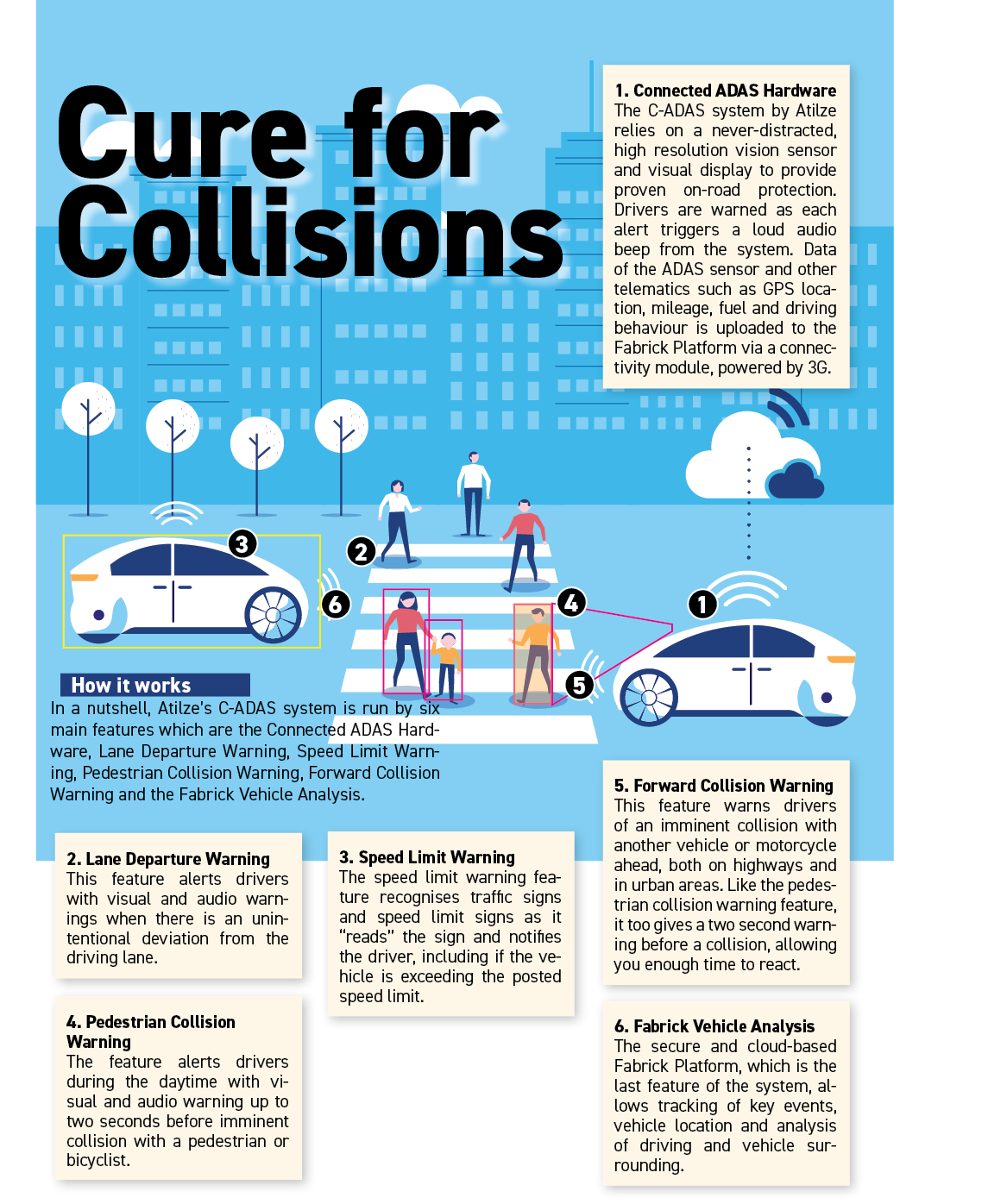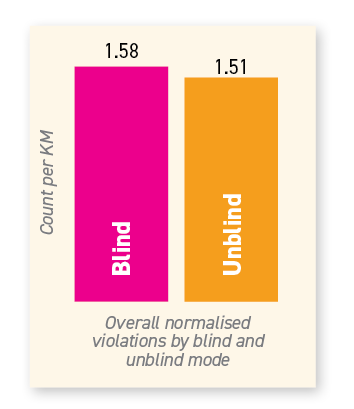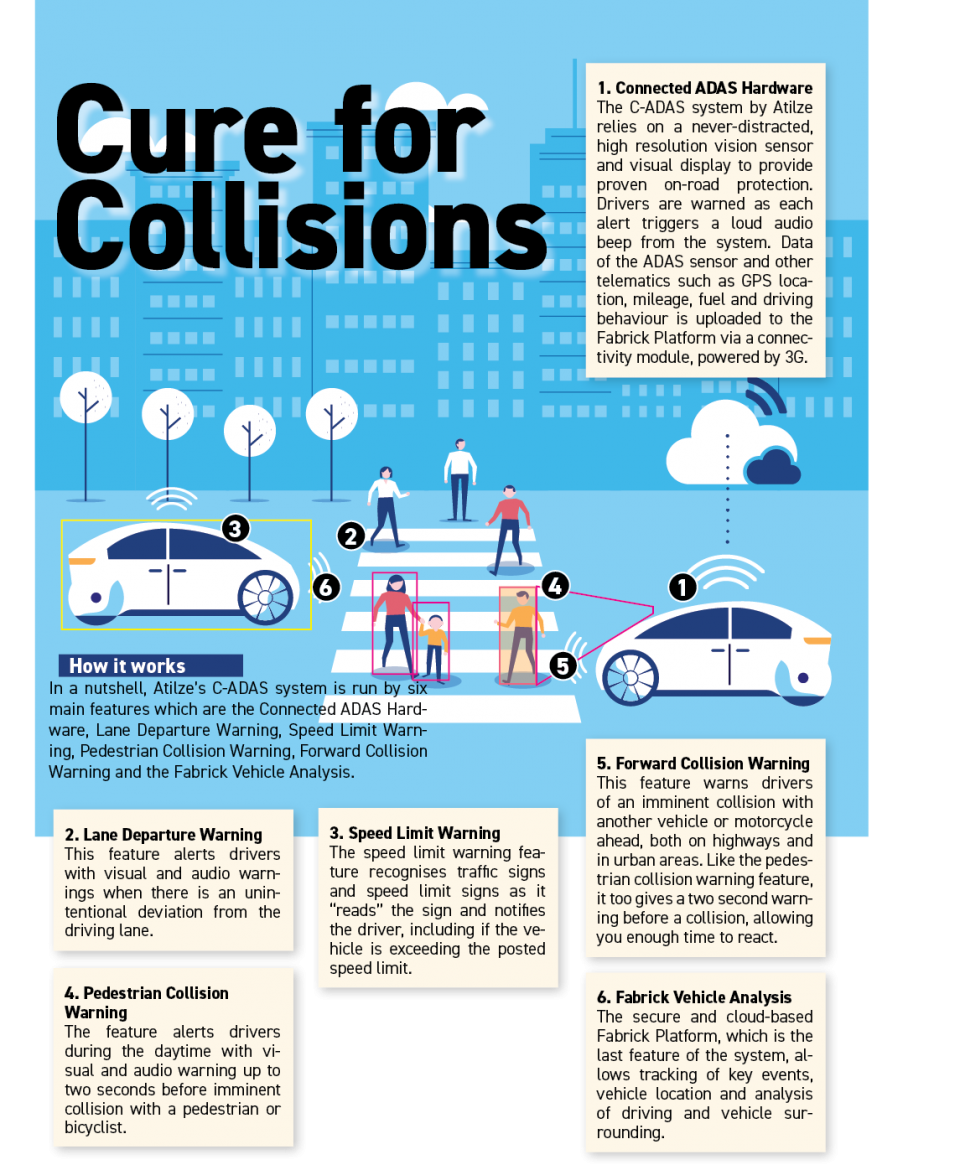
By Batrisyia Jay
Advanced driver-assistance systems (ADAS) is one of the fastest-growing segments in today’s automotive electronics industry. Thus, a growing number of modern vehicles have ADAS such as electronic stability control, anti-lock brakes, lane departure warning, adaptive cruise control and traction control wired into their system.
Human error has been identified as the main cause for most road accidents in Malaysia. The Malaysian Institute Road Safety Research (MIROS) has confirmed in its report that 80.6% of road accidents are attributed to human error while only 19.4% were the result of road and vehicle conditions.
This is where the ADAS system comes in. The system is developed to automate, adapt and enhance vehicle systems for safety and better driving. The automated system provided by ADAS to vehicles has proven to reduce road fatalities by reducing the input of human error. This is done by the system providing continuous monitoring of the vehicle and its surroundings while automatically alerting the driver when dangerous conditions are detected.
A third eye
The connected advanced driver-assistance system (C-ADAS) provided by Atilze Digital Sdn. Bhd. offers strong value propositions around predictive maintenance, real-time diagnostics and emergency response while boosting the fun in every drive with lifestyle applications and benefits through their ecosystem partners.
Safety features designed for the system are wired to avoid collisions and accidents by offering technologies that alerts the driver to potential problems, or to avoid collisions by implementing safeguards and taking over control of the vehicle.
These include features such as the Forward Collision Warning, Lane Departure Warning, Pedestrian Collision Warning and Speed Limit Warning. Through the early warning system, drivers will be able to instantly take corrective actions to prevent collisions and accidents, thus reducing loss of lives and assets.
A high technology Internet of Things (IoT) venture of Yen Global Berhad, Atilze Digital Sdn. Bhd. supplies IoT and connected objects hardware devices, cloud-based data-driven applications and services for Connected Cars and solutions built on Low-Power Wide-Area Network (LPWAN) especially on LoRa technologies.
“Sometimes it’s the technology, but most of the time it’s about the people adopting and trusting the solutions,” says Gerard Lim, CEO of Atilze Sdn. Bhd.
According to Gerard, incorporating a new technology or solution means making some fundamental changes in how we do everyday things.
“That creates a shift, a shift in the mind-set and in doing things differently that will then create the sort of efficiencies and benefits that come with a particular solution,” he says.
When asked how Atilze comes up with its solutions for an industry, Gerard says that the first move is to understand what the customer’s problem statement is. “We must find out what are the issues and challenges faced in a particular industry or with a particular customer first,” explains Gerard.
The C-ADAS system is one of the many solutions provided by the tech company that acts as a driver’s third eye by constantly monitoring the front of the vehicle and identifying potentially fatal situations prior to it occurring.”
“As the study shows, up to 80% of road accidents are caused on human error, such as bad judgements of the driver, or the driver getting distracted by something. The solution we have, as is with all our solutions, tries to take the human element out of the equation,” he says.
Once we have an autonomous self-driving car on the road, this will mean that 100% of all vehicles on the road is not driven by human but by computers instead. Thus, road accidents will be at rate of zero percent, which is why it is important for the solution to remove traces of the human element out from its system.
A verified system
The ADAS system can be affected by mechanical alignment adjustments. Thus, on 12 March 2018, Atilze had conducted an analytical study to monitor and record the behaviour of drivers in relation to driving errors, and to investigate the effect of ADAS on driving behaviour via its audio-visual alerts through a dashboard instrument.
The study involved the installation of ADAS devices on 10 commercial vehicles belonging to Martin-Brower Malaysia Co. Sdn Bhd; a global logistic service provider for restaurant chains.
The duration of this study was 10 weeks, where there were multiple drivers on rotation for each of the vehicle. Data was collected on the driving violations accumulated for each of the vehicles in two phases, the blind and unblind mode.
The blind mode refers to a passive recording of the violations by the ADAS without alerts while the unblind mode refers to a recording of the violations by ADAS, as well as audio and visual alerts triggered upon detection of violations, meant to promote immediate corrective actions by the drivers.
The conclusion of this study, which ended on 12 June 2018, showed that during the unblind mode, there is an average of 4% of drop in driving violation incidences across vehicles as compared to the blind mode.

“Atilze’s C-ADAS system assists us in meeting our business objectives of timely deliveries to customers, and to have visibility of our driver and vehicle movements,” says a Martin-Brower representative, validating that the ADAS system, with its audio-visual triggers, can indeed reduce driver-related errors and increase overall road safety.
Beyond saving lives
While it is proven that the system is successful at reducing lives and assets loss on the road, it is also efficient in reducing the government’s revenue spent on road accidents in Malaysia.
According to the latest report from MIROS as quoted in The Star, road accidents cost Malaysia RM9.2bil in 2016, or 1% of the GDP. 80.6% of the 521,466 accidents recorded in 2016 are attributed to human error.
The table expands on percentage road accidents caused by different types of violations. Highest violations such as dangerous turning and careless driving can be reduced by the implementation of the ADAS system. On that account, once adopted, the system is able to benefit individuals as well as government agencies.
The ADAS system, in a nutshell, provides drivers with important information about their surroundings as well as automating some tasks to increase safety. Manufacturers worldwide are clamouring to invest in this area in order to assist in distinguishing their vehicles from others in the market. What’s more, the same technologies that enable the ADAS system could also be implemented in the future to create fully autonomous vehicles.
While it might be a long stretch for Malaysia to adopt an autonomous driving system, having the Advanced driver-assistance system implemented into Malaysia’s automotive industry is certainly the right step towards ensuring the safety and wellbeing of drivers in the country.





